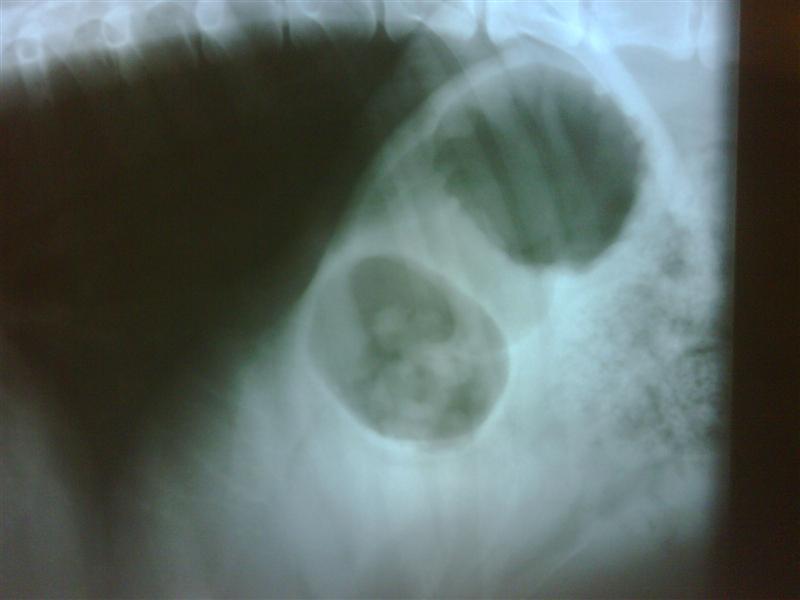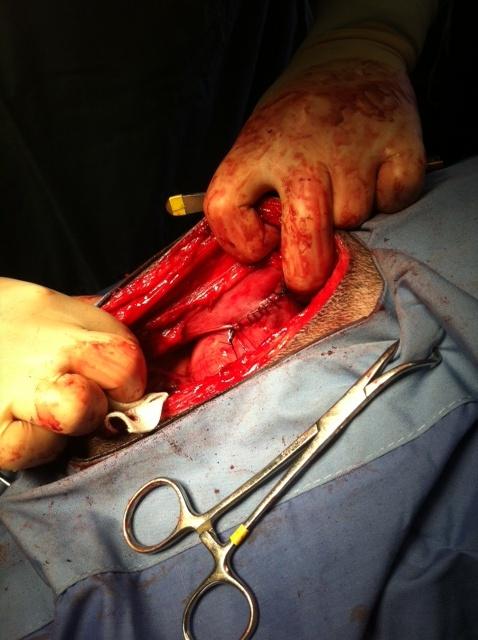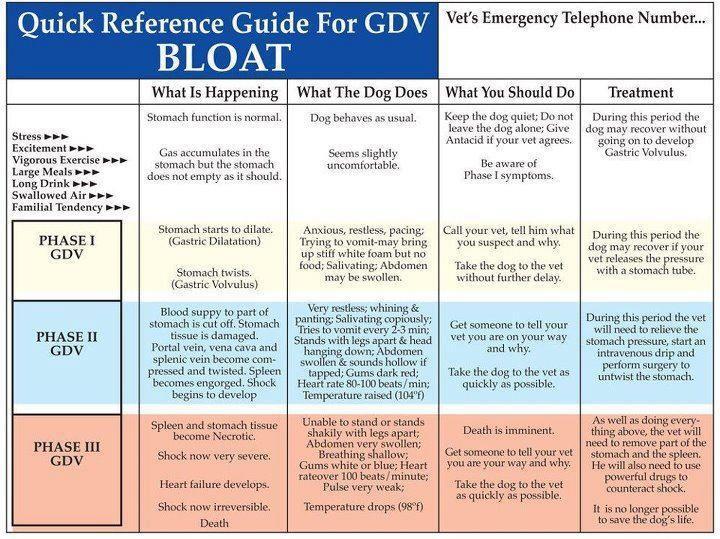Here is an article that I have put together on bloat and tort.
I am always trying to stay ‘current’ on the latest beliefs on what does or does not cause Bloat and as always, research, experience plus education has been key in forming my own beliefs. Everything stated below is not necessarily a total/complete reflection of all of my own personal plus professional beliefs on the topic, just some of the information that can be found.
One of the lessons that I try to pass along is to not just look for ‘physical’ signs/symptoms of bloat/torting; look for behavoural changes. There was very little in regards to physical changes with BHRR’s Porridge and the same could be said for our RIP beloved BLK’s Maggi plus BHRR’s Dana. “KNOW YOUR DOG” and know when he/she is not acting right!
Personally, I will say that I am not a fan of the Purdue study out there(Neither is Linda Arndt) and in working with Giant Breeds; we are often asked how many bloats/torsions we have had.
In 24+ years of operating BHRR and in almost 30 years of owning Giant Breeds; we know of 15 Giants that have bloated/torted – between our own, those that were adopted and bloated/torted in their adoptive home or in a foster/perma-foster home.
Now, as we are in our 24th year of operating BHRR(2020) & in having owned Giants for almost 30 years; we have had 10 in our own home/@BHRR. Two were within a week of each other (July 2010) and the third was almost 1.5 years later – December 2011. The fourth, BHRR’s Dana was in December of 2012. The 5th was in March of 2013, BHRR’s Abby. The 6th was in January of 2014, BHRR’s Bloom. The 7th was in December of 2014; BHRR’s Canvas The 8th was in January 2015, BHRR’s Merlin. BHRR’s Porridge had another gas bloat episode in May 2015. This is his second. The 9th is BHRR’s Sambuca(10+ years of age) in June 2017. My big blue Bronson(10+ years) is the 10th in August 2017.
My professional opinion in having owned/worked with Giants for almost 30 years; is that the following are top causes of bloat/tort:
1) Stress of which excitement is a form of stress
2) Temperament – Highly emotional, reactive and nervous dogs
3) Hereditary Factors
4) Breed tendency – Great Danes, Dobermans for example
5) Exercise too soon before or after eating
6) Once a dog has bloated, their chances are greatly increased that they shall bloat again
In these 24+ years of operating BHRR and in the almost 30 years of owning Giant Breeds; we know of 15 Giants that have bloated/torted within the following parameters:
A) those that were our own home/@ BHRR OR
B) those that were adopted out by BHRR & then bloated/torted in their adoptive home OR
C) those that were in an approved foster/perma-foster BHRR home.
They were all Great Danes.
Additionally, here is one blog ‘experience’ post made under the Gwennie Novel Blog about BHRR’s Porridge on February 22nd, 2011. BHRR’s Porridge had his second bloat incident in May of 2015.
BLOAT:
Breeds: All Great Danes.
Males: 7
Females: 8
Ages:
two(2 m) were 10+ years of age
three(1m, 2 f) being just shy of 9 years of age
one(1 m) being just shy of 8 years
one(1 f) who is 7
one(1 f) who would be 6 in 7 weeks time
one (1 f) was believed to be 4.5+ years of age – Food Bloat
one (1 f) believed to be 4+ years of age
one (1 m) believe to be approx. 4 years
one(1 m) was approx. 3.5 years
one(1 m) was approx. just over 3 years of age
one(1 f) was approx. just over 3 years of age
one (1 f) was believed to be just over 2 years of age
Details: 12 were Rescues and 3 were from highly reputable/quality Breeders.
10 of the Great Danes were in our own home at the time of the bloat/tort and two bloated within one week of each other(Maggi & Dragon).
Survival:
Two Males & five Females survived(male 3.5 years & male 10+ years) ; female – almost 9 & female – almost 6, female 7; female 4.5 years of age & female just over 3)
one Male/one Female (both just shy of 9 did not) as BHRR’s McGee( had DCM) plus he & BLK’s Maggi(July 2009) had some of the worst cases of tort that many Vets had ever seen.
The other male(just shy of 8); Grayson Danes Dragon(July 2009) did not make it due to a very poor vascular system.
The one female, BHRR’s Storm(December 2010) just over 2 years also did not make it
The one female, BHRR’s Dana(December 2012) 4.5+ years did not make it – complications – 40% stomach had gone necrotic
The one male, BHRR’s Canvas(December 2014), just over 3 years did not make it – torted so fast
The the other two males BHRR’s Sambuca and my Big Blue Bronson, both 10+ years of age did not survive. The Bloat damaged Big Blue’s heart.
The one male, BHRR’s Merlin(January 2015), food bloated on contaminated food donated by another group – being emaciated/with other medical conditions, he did not make it.
Genetics
In addition to breed predilection, there appears to be a genetic link to this disease. The incidence is closely correlated to the depth and width of the dog’s chest. The greater the chest depth/width ratio, the greater the risk of bloat. Several different genes from the parents determine these traits. If both parents have particularly deep chests, then it is highly likely that their offspring will also have the same chests and the resulting problems that may go with it. A recommendation was made that stated that no dog should be bred if there is a 1 to the 0 degree relative that has previously bloated.
Linda Arndt from the late GREATDANELADY.COM states that ‘When we limit our gene pool to specific kennel names, bloodlines, color families as well as remaining within each specific breed, this prevents us from maintaining hybrid vigor. It maximizes our chances for doubling on negative traits with the increased potential for animals that are more sensitive to stimulus (light, sound, movement) and affect the total physiological system (body functions) and their psychological system (mental/behavioral functions).’
Age
Dogs over 7 years of age are more than twice as likely to develop gastric dilatation and volvulus as those who are 2-4 years of age.
Personal Note – *7 that we are aware of were over the age of 7 – 46.6%*
Gender
Male dogs are twice as likely to develop gastric dilatation and volvulus as females. Neutering does not appear to have an effect on the risk of GDV.
Personal Note – *We are aware of more females than males – 53.3%*
Eating & Drinking
More cases are reported between April and August and between the hours of 6pm – midnight(59.3%)-Dr. Glickman Study. The season when dogs are likely to be more active and to consume more water.
Personal Note – *2 of our own were in the AM – between 8:00 – 10:00 AM and the third in our home/@BHRR – BHRR’s Storm was just before 3 PM; The fourth, BHRR’s Dana was at 9:35 PM(60-75 minutes post dinner and was a food bloat). The fifth, BHRR’s Abby was also in the evening(just prior to 9:00 PM), The sixth, BHRR’s Bloom was also in the evening(around 5:00 PM). The 7th, BHRR’s Canvas was in the AM – between 5-8 AM. The 8th, BHRR’s Merlin was in the afternoon. The 9th, BHRR’s Sambuca was at night around 9:00 pm and the month was June. The 10th was also at night time and the month was August.
Owners and Vets originally blamed cereal-based diets, yet that is still being questioned. Recent studies indicate aerophagia (air swallowing), as often happens during periods of the above activities, appears to be a cause, rather than, as previously thought, gas caused by fermentation of dog foods. Also, increased particle size of food was associated with a significantly decreased risk of GDV in Great Danes and pre-soaking of food actually destroys nutrients plus causes fermentation.
Dogs fed once a day are twice as likely to develop GDV as those fed twice a day. It appears that dogs that eat rapidly or exercise soon after a meal may also be at increased risk. Dogs fed a larger volume of food per meal were at a significantly increased risk, regardless of the number of meals fed daily. Dogs fed a higher volume of food and one meal a day were at a significantly increased risk of GDV compared to dogs fed a lower volume of food and two meals a day. Results suggest that dogs at a higher risk of Bloat by nature of their size or Breed, should be fed a lower volume of food at each meal and multiple(at least two) meals per day.
There is also a possible link between bloat and calcium supplementation that causes persistent hyper gastrinemina.
The debate still carries on about raised feeders and does it or does it not reduce/increase the incident of bloat.
Personal Note – *I* feed raised and and never had a bloat/tort and our first bloat was after 23 years of owning Giants and after 14.5 years of operating BHRR.
Temperament & Stress
Dogs that tend to be more nervous, anxious, or fearful appear to be at an increased risk of developing GDV. Per Linda Arndt in respect to stress ‘Sometimes stress is external and obvious and other times it is internal and goes unnoticed…..Some people and some dogs, due to genetics, body chemistry, nutrition and personality, seem to handle negative stress better than others.’
Causes?
There is not one particular activity that leads to the development of Bloat/GDV. It appears that it occurs as a combination of events. Studies of the stomach gas that occurs in dilatation have shown that it is similar to the composition of normal room air suggesting that the dilatation occurs as a result of swallowing air. All dogs, and people for that matter, swallow air, but normally we eructate (burp) and release this air and it is not a problem. For some reason that scientists have not yet determined, these dogs that develop bloat do not release this swallowed gas. There is currently several studies looking into what happens physiologically in these dogs that develop GDV.
Other potential causes: surgical complications, history of belching, history of flatus, aggression toward people or other dogs, eating too fast, unrestricted activity following meals and large amounts of water consumption.
“Happy/easy going” dogs were found to be less prone to bloat.
Once a dog has bloated, there is a good chance that he/she will bloat again.
Other helpful suggestions to help decrease the chances of Bloat:
*Never feed your dog immediately before or after heavy work out or training session.
*Be sure that you are not restricting proper water intake
*Do not allow your dog to become overweight.
*Be canine-connected and watch for odd symptoms, abdominal swelling, dry vomiting, strange gagging, drooling, pale gums, painful to palpate, extreme restlessness, excessive stretching etc.
*If you have a nervous dog, feed her/him in a quite relaxed atmosphere.
*If you plan on changing your dogs diet, start slowly. Sudden diet changes will cause gastric problems.
*Feed on a consistent routine schedule
*Gastropexy – Dr. Glickman of 1934 dogs studied – reported that the recurrence of bloat decreased from 4% to 0.3% per month & lifetime recurrence rate of 80% dropped to 3-5% with Gastropexy.
The Genetics of Bloat – Researchers hope their work will help predict which dogs may get the deadly disease. Article published November 2014.
Tort/Twisting (Volvulus) Details:
As the stomach swells, it may rotate 90° to 360°, twisting between its fixed attachments at the esophagus (food tube) and at the duodenum (the upper intestine). The twisting stomach traps air, food, and water in the stomach. The bloated stomach obstructs veins in the abdomen, leading to low blood pressure, shock, and damage to internal organs. The combined effect can quickly kill a dog.

BHRR’s Mazda – March 1st, 2011 – partial / 90 degree flip – ‘left side up’
Photo courtesy of The Twaddles – adoptive home of BHRR’s Mazda since 2009
![MicroDicom - [IMAGE001]_2012-12-23_21-32-28](http://www.birchhaven.org/wp-content/uploads/2009/04/MicroDicom-IMAGE001_2012-12-23_21-32-28.jpg)
BHRR’s Dana – December 18th, 2012 – Food Bloat – Partial – ‘Right side up’
X-Ray taken at Alta Vista Animal Hospital
Possible Signs & Symptoms:
- Attempts to vomit – usually unsuccessfully (foam and/or mucous only)
- Doesn’t act like self – Perhaps the earliest warning sign and may be the only sign that almost always occurs
- Anxiety and restlessness
- Hunched or roached
- Lack of normal gurgling or tummy sounds
- Bloated abdomen
- Gums – Dark red in early stages; white or blue in later stages
- Coughing or gagging
- Drooling
- Foam or mucous around mouth or lips
- Trying to poop
- Whining
- Pacing
- Looking for a place to hide
- Looking or nipping at sides/belly
- Do not want to lay down or are very uncomfortable in trying to lay down
- May stand spread-eagled
- Trying to curl up in a ball
- Trying to eat grass
- Wanting to drink a lot
- Heavy or rapid panting
- Shallow breathing
- Membranes in mouth are cold
- Weakness to stand/walk- very apparent in later stages
- Weak pulse
- Collapsing
- Accelerated heartrate
Full Moon Bloat Calendar
http://www.danebytes.com/bloatmoon.htm
Other Bloat Articles that I have bookmarked
http://www.cfgdr.org/bloatarticles.htm
Quick Reference Guide to Bloat (including signs/symptoms)
Additional Info:
A gastropexy will not prevent your dog from bloating but it will decrease the probability of bloat by allowing your dog to burp and pass excess gas through the stomach to the rest of the intestinal tract. But a gastropexy, if done correctly, will prevent the stomach from turning on its axis, resulting in a critical, life threatening situation. Bloat itself can kill your dog but not as quickly as GDV will kill him. If the stomach cannot rotate, the time your dog has gained, even during the bloat episode, may be enough to save his life.
Also, though rare, with repeat dilation, the pexy site can be broken down and lead to torsion in the future.
Different Types of Gastropexy:
belt-loop gastropexy
a modification of the circumcostal technique in which the seromuscular gastric flap is passed around a loop of transverse abdominal muscle instead of a rib.Fast, simple, strong. Decreased risk of stomach leakage. Stomach fixed to Right abdominal wall. Requires more skill than incisional pexy. Belt loop gastropexy has a much lower recurrence rate of torsion than tube gastrotomy as well as a much stronger adhesion than either tube gastrotomy or incisional.
circumcostal gastropexy
fixation by a flap of gastric serosa and muscularis anchored around a rib. Strong, decreased risk of stomach leakage. Stomach fixed to Right abdominal wall. Risk of pneumothorax, risk of rib fracture. Requires more time to do, more difficult. Circumcostal gastropexy has comparable strength to the belt loop gastropexy.
fast, simple. Stomach fixed to Right abdominal wall. Decreased risk of stomach leakage. More variation in healing and resultant strength. Relies on only a few sutures in place until adhesion forms. More variation in healing and resultant strength. Relies on only a few sutures in place until adhesion forms.
this procedure is a minimally invasive means by which to permanently pexy (secure) the stomach to the abdominal wall in such a manner that future gastric volvulus or torsion is prevented. Minimally invasive surgical techniques allow the surgeon to perform major operations through minimal surgical incisions.
permanent incisional gastropexy
edges of an incision into the seromuscular layers of the pyloric antrum are sutured to an incision into the peritoneum and internal fascia of the rectus abdominal or transverse abdominal muscles.
tube gastropexy
a method using a Foley catheter placed in the pyloric antrum and through the abdominal wall in the right paracostal area during the postsurgical period. Not as strong and, the tube must remain in the stomach of the dog for at least one week.
ventral gastropexy
fast. Decreased risk of stomach leakage. Adhesions may impair future surgery if ever needed. Difficult due to depth of the BH abdomen.
The one trend that I have begun to also see through my years working in animal medicine and in Rescue; is that there are more and more cases of younger dogs bloating.
NOTE: gastropexy’s can and do fail. It is not 100%.
*The Great Dane was the #1 Breed at risk for Bloat; the Saint Bernard was the #2 Breed and the Weimaraner was the #3 breed.

BHRR’s Abby’s Pexy – March 15th, 2013
*@ Kanata Animal Hospital
QUICK ‘CHEAT’ CHART – NOTE: NOT ALL DOGS ARE “CLASSIC” IN PRESENTATION – KNOW YOUR DOG!
Author: Gwendilin Boers
